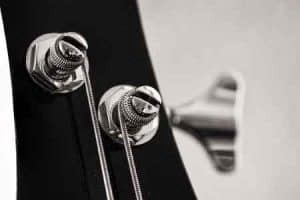
Tuning A 5 String Bass Guitar
Bass guitars originally had 4 strings, but now the 5 String Bass Guitar is probably the most popular due to its expanded versatility.
One of the first skills that a beginning bass guitar player needs is the ability to tune the bass guitar. You can?t get a decent sound from a bass guitar that is out of tune, no matter how well you play or how hard you try.
Just like you will have to make a regular habit of practicing if you are to learn how to play well, knowing how to tune your bass guitar takes practice too. It is essential and it will make your practice sessions more fun and rewarding. Technology has made tuning a breeze, so you should always be able to have an instrument that is well tuned.
The basics of Tuning Your Bass Guitar
- Tuning is controlled by the tuning pegs on the headstock of your bass guitar.
- When you turn the pegs, you change the pitch by tightening or loosening the string.
- If you tighten the string, the pitch goes up.
- If you loosen the string, the pitch goes down.
How Often Should You Tune Your Bass Guitar?
- That is simple, you should tune your bass guitar every time you play it.
- It most likely will not stay in tune between practice sessions.
- Bass guitars, as a rule, stay in tune longer than other guitars, but you still want to tune it every time you play.
- If it sounds somewhat off or just not quite right when playing, check its tuning.

How Do You Tune Your Bass Guitar?
For tuning your bass guitar, there are three common methods.
- Tune the bass guitar by ear. Play what is called a ?reference note? from another instrument, tuning fork or pitch pipe and adjust your strings to match the sounds that they make.
- Use a clip-on electric tuner. You can purchase and use it to adjust your strings.
- Use an online tuner. They are most often free.
Tuning a Bass Guitar by Using Another Instrument as a Reference
You can tune your bass guitar using a reference pitch from another instrument, like a piano, that you know is in tune. It is a little more difficult to tune with this method since you have to tune one of your strings to the reference pitch ?by ear?. This means you must listen to the reference pitch, play the same note on your bass guitar and compare the pitches.
Once the note matches the reference pitch, and the string is in tune, you can tune your bass guitar to itself. To do this you play a fretted note on a lower string and then tune your open strings to match that pitch.
Tuning Your Bass Guitar with a Clip-on Electric Tuner
Tuning has become much simpler with the advent of clip-on electric tuners. You had to plug in the old-fashioned tuners, but clip-on electric tuners attach to the headstock of your guitar and sense the vibrations of each string. They will indicate which notes are flat (too low) or sharp (too high) or in tune.
It is possible that some clip-on electric tuners will have difficulty picking up the E string (the lowest note). Consequently, when you are shopping for one, check to see if it can read the low string. Clip-on electric tuners are inexpensive, accurate and easy to use.
Tuning a Bass Guitar without a Pitch Tuner on Your Smartphone
Download a tuner app on your smartphone. There are hundreds of these to choose from and many of them are free. These apps use the built-in microphone in your smartphone to hear the pitch of the strings. As you adjust the tuning peg for each string on your bass guitar, the display on your smartphone will tell you when it is in tune.
Standard Bass Guitar Tuning
A Standard Bass Guitar has only 4 strings. The standard tuning for it is E, A, D, G, the same as the 4 lowest strings on a guitar, but one octave lower. The bass guitar strings are tuned in fourths. School of Rock has a whimsical way to memorize bass strings bottom to top:
E at
A
D ead
G rasshopper
5 String Bass Guitars are becoming more common. To tune them you add an extra low string B, E, A, D, G or by adding an extra high string E, A, D, G, C.

Drop D Tuning for Bass Guitars
This is a simple way to tune without adding extra strings. Drop tunings became popular in the 1990s for heavier music. To Drop tune, you lower the pitch of your lowest string, usually a whole step below standard.
Drop D tuning is done when you lower the E string a whole step down to D. This makes the D note a fifth below the next highest string. This expands the tonal range of your bass guitar and makes it sound ?heavy?.
Drop D tuning is quite popular. (D, A, D, G) Metal groups often go even lower to Drop C (C, G, C, F).
There are Drop D tuners available that let you change the tuning of your bass guitar easily.
How to Keep Your Bass Guitar in Tune
You want it to stay in tune for as long as possible, so be sure to:
- Change your strings often.
- Keep your bass guitar clean.
- Keep your bass guitar in its case when not in use.
Conclusion:
For tuning your bass guitar, there are three common methods.
- Tune the bass guitar by ear. Play what we call a ?reference note? from another instrument, tuning fork or pitch pipe and adjust your strings to match the sounds that they make.
- Use a clip-on electric tuner. You can purchase and one to adjust your strings.
- Use an online tuner. They are most often free.
Whichever tuning method you choose, by ear, with a clip-on electric tuner or with an online tuner, if you follow the steps and principles outlined in this article, you will always have a bass guitar that is in tune, stays in tune and is delightful to play, especially playing bass guitar for worship. Happy playing!
Originally published at https://easychurchtech.com.

